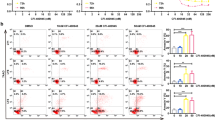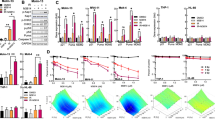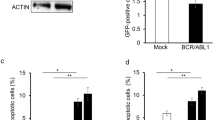Abstract
Anthracyclines have been a cornerstone in the cure of diffuse large B-cell lymphoma (DLBCL) and other hematological cancers. The ability of anthracyclines to eliminate DLBCL depends on the presence of topoisomerase-II-alpha (TopIIA), a DNA repair enzyme complex. We identified nucleolin as a novel binding partner of TopIIA. Abrogation of nucleolin sensitized DLBCL cells to TopIIA targeting agents (doxorubicin/etoposide). Silencing nucleolin and challenging DLBCL cells with doxorubicin enhanced the phosphorylation of H2AX (γH2AX-marker of DNA damage) and allowed DNA fragmentation. Reconstitution of nucleolin expression in nucleolin-knockdown DLBCL cells prevented TopIIA targeting agent-induced apoptosis. Nucleolin binding to TopIIA was mapped to RNA-binding domain 3 of nucleolin, and this interaction was essential for blocking DNA damage and apoptosis. Nucleolin silencing decreased TopIIA decatenation activity, but enhanced formation of TopIIA–DNA cleavable complexes in the presence of etoposide. Moreover, combining nucleolin inhibitors: aptamer AS1411 or nucant N6L with doxorubicin reduced DLBCL cell survival. These findings are of clinical importance because low nucleolin levels versus high nucleolin levels in DLBCL predicted 90-month estimated survival of 70% versus 12% (P<0.0001) of patients treated with R-CHOP-based therapy.
This is a preview of subscription content, access via your institution
Access options
Subscribe to this journal
Receive 12 print issues and online access
$259.00 per year
only $21.58 per issue
Buy this article
- Purchase on Springer Link
- Instant access to full article PDF
Prices may be subject to local taxes which are calculated during checkout






Similar content being viewed by others
References
Friedberg JW, Fisher RI . Diffuse large B-cell lymphoma. Hematol Oncol Clin North Am 2008; 22: 941–952, ix.
Siegel R, DeSantis C, Virgo K, Stein K, Mariotto A, Smith T et al. Cancer treatment and survivorship statistics, 2012. CA Cancer J Clin 2012; 62: 220–241.
Nitiss JL . DNA topoisomerase II and its growing repertoire of biological functions. Nat Rev Cancer 2009; 9: 327–337.
Chikamori K, Grozav AG, Kozuki T, Grabowski D, Ganapathi R, Ganapathi MK . DNA topoisomerase II enzymes as molecular targets for cancer chemotherapy. Curr Cancer Drug Targets 2010; 10: 758–771.
Arriola E, Rodriguez-Pinilla SM, Lambros MB, Jones RL, James M, Savage K et al. Topoisomerase II alpha amplification may predict benefit from adjuvant anthracyclines in HER2 positive early breast cancer. Breast Cancer Res Treat 2007; 106: 181–189.
Press MF, Sauter G, Buyse M, Bernstein L, Guzman R, Santiago A et al. Alteration of topoisomerase II-alpha gene in human breast cancer: association with responsiveness to anthracycline-based chemotherapy. J Clin Oncol 2011; 29: 859–867.
Scandinavian Breast Group T Scandinavian Breast Group T Tanner M Scandinavian Breast Group T Isola J Scandinavian Breast Group T Wiklund T Scandinavian Breast Group T Erikstein B Scandinavian Breast Group T Kellokumpu-Lehtinen P et al. Topoisomerase IIalpha gene amplification predicts favorable treatment response to tailored and dose-escalated anthracycline-based adjuvant chemotherapy in HER-2/neu-amplified breast cancer: Scandinavian Breast Group Trial 9401. J Clin Oncol 2006; 24: 2428–2436.
Goldstein M, Derheimer FA, Tait-Mulder J, Kastan MB . Nucleolin mediates nucleosome disruption critical for DNA double-strand break repair. Proc Natl Acad Sci USA 2013; 110: 16874–16879.
Kobayashi J, Fujimoto H, Sato J, Hayashi I, Burma S, Matsuura S et al. Nucleolin participates in DNA double-strand break-induced damage response through MDC1-dependent pathway. PLoS One 2012; 7: e49245.
Fogal V, Sugahara KN, Ruoslahti E, Christian S . Cell surface nucleolin antagonist causes endothelial cell apoptosis and normalization of tumor vasculature. Angiogenesis 2009; 12: 91–100.
Pichiorri F, Palmieri D, De Luca L, Consiglio J, You J, Rocci A et al. In vivo NCL targeting affects breast cancer aggressiveness through miRNA regulation. J Exp Med 2013; 210: 951–968.
Wise JF, Berkova Z, Mathur R, Zhu H, Braun FK, Tao RH et al. Nucleolin inhibits Fas ligand binding and suppresses Fas-mediated apoptosis in vivo via a surface nucleolin-Fas complex. Blood 2013; 121: 4729–4739.
Qiu W, Zhou F, Zhang Q, Sun X, Shi X, Liang Y et al. Overexpression of nucleolin and different expression sites both related to the prognosis of gastric cancer. APMIS 2013; 121: 919–925.
Otake Y, Soundararajan S, Sengupta TK, Kio EA, Smith JC, Pineda-Roman M et al. Overexpression of nucleolin in chronic lymphocytic leukemia cells induces stabilization of bcl2 mRNA. Blood 2007; 109: 3069–3075.
Bharti AK, Olson MO, Kufe DW, Rubin EH . Identification of a nucleolin binding site in human topoisomerase I. J Biol Chem 1996; 271: 1993–1997.
Yang C, Kim MS, Chakravarty D, Indig FE, Carrier F . Nucleolin binds to the proliferating cell nuclear antigen and inhibits nucleotide excision repair. Mol Cell Pharmacol 2009; 1: 130–137.
Jain N, Thanabalu T . Molecular difference between WASP and N-WASP critical for chemotaxis of T-cells towards SDF-1alpha. Sci Rep 2015; 5: 15031.
Mathur R, Chandna S, N Kapoor P, S Dwarakanath B . Peptidyl prolyl isomerase, Pin1 is a potential target for enhancing the therapeutic efficacy of etoposide. Curr Cancer Drug Targets 2011; 11: 380–392.
Visco C, Li Y, Xu-Monette ZY, Miranda RN, Green TM, Li Y et al. Comprehensive gene expression profiling and immunohistochemical studies support application of immunophenotypic algorithm for molecular subtype classification in diffuse large B-cell lymphoma: a report from the International DLBCL Rituximab-CHOP Consortium Program Study. Leukemia 2012; 26: 2103–2113.
Visco C, Tzankov A, Xu-Monette ZY, Miranda RN, Tai YC, Li Y et al. Patients with diffuse large B-cell lymphoma of germinal center origin with BCL2 translocations have poor outcome, irrespective of MYC status: a report from an International DLBCL rituximab-CHOP Consortium Program Study. Haematologica 2013; 98: 255–263.
Xu-Monette ZY, Wu L, Visco C, Tai YC, Tzankov A, Liu WM et al. Mutational profile and prognostic significance of TP53 in diffuse large B-cell lymphoma patients treated with R-CHOP: report from an International DLBCL Rituximab-CHOP Consortium Program Study. Blood 2012; 120: 3986–3996.
Hummel M, Bentink S, Berger H, Klapper W, Wessendorf S, Barth TF et al. A biologic definition of Burkitt's lymphoma from transcriptional and genomic profiling. N Engl J Med 2006; 354: 2419–2430.
Lenz G, Wright G, Dave SS, Xiao W, Powell J, Zhao H et al. Stromal gene signatures in large-B-cell lymphomas. N Engl J Med 2008; 359: 2313–2323.
Mathur R, Sehgal L, Havranek O, Kohrer S, Khashab T, Jain N et al. Inhibition of demethylase KDM6B sensitizes diffuse large B-cell lymphoma to chemotherapeutic drugs. Haematologica 2017; 102: 373–380.
Abdelmohsen K, Gorospe M . RNA-binding protein nucleolin in disease. RNA Biol 2012; 9: 799–808.
Mah LJ, El-Osta A, Karagiannis TC . gammaH2AX: a sensitive molecular marker of DNA damage and repair. Leukemia 2010; 24: 679–686.
Karpinich NO, Tafani M, Schneider T, Russo MA, Farber JL . The course of etoposide-induced apoptosis in Jurkat cells lacking p53 and Bax. J Cell Physiol 2006; 208: 55–63.
Kurz EU, Douglas P, Lees-Miller SP . Doxorubicin activates ATM-dependent phosphorylation of multiple downstream targets in part through the generation of reactive oxygen species. J Biol Chem 2004; 279: 53272–53281.
Schonn I, Hennesen J, Dartsch DC . Ku70 and Rad51 vary in their importance for the repair of doxorubicin- versus etoposide-induced DNA damage. Apoptosis 2011; 16: 359–369.
Willmore E, de Caux S, Sunter NJ, Tilby MJ, Jackson GH, Austin CA et al. A novel DNA-dependent protein kinase inhibitor, NU7026, potentiates the cytotoxicity of topoisomerase II poisons used in the treatment of leukemia. Blood 2004; 103: 4659–4665.
Grozav AG, Chikamori K, Kozuki T, Grabowski DR, Bukowski RM, Willard B et al. Casein kinase I delta/epsilon phosphorylates topoisomerase IIalpha at serine-1106 and modulates DNA cleavage activity. Nucleic Acids Res 2009; 37: 382–392.
Ritke MK, Murray NR, Allan WP, Fields AP, Yalowich JC . Hypophosphorylation of topoisomerase II in etoposide (VP-16)-resistant human leukemia K562 cells associated with reduced levels of beta II protein kinase C. Mol Pharmacol 1995; 48: 798–805.
Pentheroudakis G, Goussia A, Voulgaris E, Nikolaidis K, Ioannidou E, Papoudou-Bai A et al. High levels of topoisomerase IIalpha protein expression in diffuse large B-cell lymphoma are associated with high proliferation, germinal center immunophenotype, and response to treatment. Leuk Lymphoma 2010; 51: 1260–1268.
Chen Z, Wang J, Zhang H, Liu D, Li Y, Xu Y et al. Topo IIalpha gene alterations correlated with survival in patients with diffuse large B-cell lymphoma. Eur J Clin Invest 2012; 42: 310–320.
Koutsioumpa M, Papadimitriou E . Cell surface nucleolin as a target for anti-cancer therapies. Recent Pat Anticancer Drug Discov 2014; 9: 137–152.
Cardenas ME, Walter R, Hanna D, Gasser SM . Casein kinase II copurifies with yeast DNA topoisomerase II and re-activates the dephosphorylated enzyme. J Cell Sci 1993; 104 (Pt 2): 533–543.
Alghisi GC, Roberts E, Cardenas ME, Gasser SM . The regulation of DNA topoisomerase II by casein kinase II. Cell Mol Biol Res 1994; 40: 563–571.
Lou Z, Minter-Dykhouse K, Chen J . BRCA1 participates in DNA decatenation. Nat Struct Mol Biol 2005; 12: 589–593.
Kurz EU, Leader KB, Kroll DJ, Clark M, Gieseler F . Modulation of human DNA topoisomerase IIalpha function by interaction with 14-3-3epsilon. J Biol Chem 2000; 275: 13948–13954.
Srivastava M, Pollard HB . Molecular dissection of nucleolin's role in growth and cell proliferation: new insights. FASEB J 1999; 13: 1911–1922.
Jackson SP, Bartek J . The DNA-damage response in human biology and disease. Nature 2009; 461: 1071–1078.
d'Adda di Fagagna F . Living on a break: cellular senescence as a DNA-damage response. Nat Rev Cancer 2008; 8: 512–522.
Korwek Z, Sewastianik T, Bielak-Zmijewska A, Mosieniak G, Alster O, Moreno-Villanueva M et al. Inhibition of ATM blocks the etoposide-induced DNA damage response and apoptosis of resting human T cells. DNA Repair 2012; 11: 864–873.
Chen CY, Gherzi R, Andersen JS, Gaietta G, Jurchott K, Royer HD et al. Nucleolin and YB-1 are required for JNK-mediated interleukin-2 mRNA stabilization during T-cell activation. Genes Dev 2000; 14: 1236–1248.
Gao G, Dou QP . G(1) phase-dependent expression of bcl-2 mRNA and protein correlates with chemoresistance of human cancer cells. Mol Pharmacol 2000; 58: 1001–1010.
Berger CM, Gaume X, Bouvet P . The roles of nucleolin subcellular localization in cancer. Biochimie 2015; 113: 78–85.
Hovanessian AG . Midkine, a cytokine that inhibits HIV infection by binding to the cell surface expressed nucleolin. Cell Res 2006; 16: 174–181.
Said EA, Courty J, Svab J, Delbe J, Krust B, Hovanessian AG . Pleiotrophin inhibits HIV infection by binding the cell surface-expressed nucleolin. FEBS J 2005; 272: 4646–4659.
Chen YL, Liu CD, Cheng CP, Zhao B, Hsu HJ, Shen CL et al. Nucleolin is important for Epstein-Barr virus nuclear antigen 1-mediated episome binding, maintenance, and transcription. Proc Natl Acad Sci USA 2014; 111: 243–248.
Balinsky CA, Schmeisser H, Ganesan S, Singh K, Pierson TC, Zoon KC . Nucleolin interacts with the dengue virus capsid protein and plays a role in formation of infectious virus particles. J Virol 2013; 87: 13094–13106.
Tayyari F, Marchant D, Moraes TJ, Duan W, Mastrangelo P, Hegele RG . Identification of nucleolin as a cellular receptor for human respiratory syncytial virus. Nat Med 2011; 17: 1132–1135.
Bates PJ, Laber DA, Miller DM, Thomas SD, Trent JO . Discovery and development of the G-rich oligonucleotide AS1411 as a novel treatment for cancer. Exp Mol Pathol 2009; 86: 151–164.
Gilles ME, Maione F, Cossutta M, Carpentier G, Caruana L, Di Maria S et al. Nucleolin targeting impairs the progression of pancreatic cancer and promotes the normalization of tumor vasculature. Cancer Res 2016; 76: 7181–7193.
Krust B, El Khoury D, Nondier I, Soundaramourty C, Hovanessian AG . Targeting surface nucleolin with multivalent HB-19 and related Nucant pseudopeptides results in distinct inhibitory mechanisms depending on the malignant tumor cell type. BMC Cancer 2011; 11: 333.
Mongelard F, Bouvet P . AS-1411, a guanosine-rich oligonucleotide aptamer targeting nucleolin for the potential treatment of cancer, including acute myeloid leukemia. Curr Opin Mol Ther 2010; 12: 107–114.
Ireson CR, Kelland LR . Discovery and development of anticancer aptamers. Mol Cancer Ther 2006; 5: 2957–2962.
Damian Laber BT, Kloecker G, Acton G, Miller D . Pharmacokinetics of the Anti-Nucleolin Aptamer AS1411 in a Phase I Study. American Association for Cancer Research: San Francisco, CA, 2007.
Alibolandi M, Ramezani M, Abnous K, Hadizadeh F . AS1411 aptamer-decorated biodegradable polyethylene glycol-poly(lactic-co-glycolic acid) nanopolymersomes for the targeted delivery of gemcitabine to non-small cell lung cancer in vitro. J Pharmaceut Sci 2016; 105: 1741–1750.
Trinh TL, Zhu G, Xiao X, Puszyk W, Sefah K, Wu Q et al. A synthetic aptamer-drug adduct for targeted liver cancer therapy. PLoS ONE 2015; 10: e0136673.
Destouches D, Page N, Hamma-Kourbali Y, Machi V, Chaloin O, Frechault S et al. A simple approach to cancer therapy afforded by multivalent pseudopeptides that target cell-surface nucleoproteins. Cancer Res 2011; 71: 3296–3305.
Acknowledgements
This work was supported by National Cancer Institute grant (CA 1206173), National Institute of Diabetes and Digestive and Kidney Diseases grant (DK091490), the Richard Spencer Lewis Memorial Foundation, and patients’ families. The MD Anderson Flow Cytometry and Cellular Imaging Facility are supported by the NIH/NCI under award number P30CAQ16672.
Author contributions
NJ, HFZ LS and FS designed the research studies, analyzed the data and wrote the manuscript. NJ, HFZ, BG, TK, QY, RM, RKS, FKB, XW, ZB, JW, XYXM and KHY performed experiments, analyzed the data and contributed to clinical resources under approved IRB. QY and KHY analyzed the tissue staining, quantified protein expression and identified correlations with patient clinical outcome. LS and FS contributed to the research design, writing and finalized the manuscript.
Author information
Authors and Affiliations
Corresponding authors
Ethics declarations
Competing interests
The authors declare no conflict of interest.
Additional information
Supplementary Information accompanies this paper on the Leukemia website
Supplementary information
Rights and permissions
About this article
Cite this article
Jain, N., Zhu, H., Khashab, T. et al. Targeting nucleolin for better survival in diffuse large B-cell lymphoma. Leukemia 32, 663–674 (2018). https://doi.org/10.1038/leu.2017.215
Received:
Revised:
Accepted:
Published:
Issue Date:
DOI: https://doi.org/10.1038/leu.2017.215
This article is cited by
-
Bioinformatics analysis of the pathogenic link between Epstein-Barr virus infection, systemic lupus erythematosus and diffuse large B cell lymphoma
Scientific Reports (2023)
-
Targeting nucleolin improves sensitivity to chemotherapy in acute lymphoblastic leukemia
Cellular Oncology (2023)
-
Progress in cancer drug delivery based on AS1411 oriented nanomaterials
Journal of Nanobiotechnology (2022)
-
Cellular localization of nucleolin determines the prognosis in cancers: a meta-analysis
Journal of Molecular Medicine (2022)
-
Modelling the impact of nucleolin expression level on the activity of F3 peptide-targeted pH-sensitive pegylated liposomes containing doxorubicin
Drug Delivery and Translational Research (2022)



